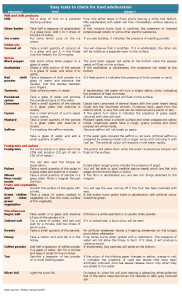Dec.18: COVER STORY
- Posted by CERC India
- Posted in DCMBR
Simple home tests to detect food adulteration
Vigilant consumers vital to curb adulteration and ensure safe food for all
Detergent in milk. Chalk powder in sugar. Iron filings in tea. Clay in coffee powder.  Isn’t that enough to make your morning beverage a dangerous proposition? Not to mention your breakfast, lunch and dinner. That’s because you may just find papaya seeds in your pepper grinder, saw dust in your bottle of cumin powder and artificial colours on the fruits and vegetables you have picked so carefully at the greengrocer’s.
These are just a few examples of food adulteration that the Indian consumer faces in everyday life. With the aim to raise consumer awareness on adulteration and food safety, the Food Safety and Standards Authority of India (FSSAI) has released a manual. The book Detect Adulteration with Rapid Test (DART) lists easy to do, inexpensive tests that can be done at home to quickly detect adulterants in common food items.
How food gets adulterated
Adulteration of food is defined as the addition or subtraction of any substance to or from food, so that the natural composition and quality of the food is affected. Adulteration can be intentional (done for economic gain) or unintentional. Two examples of intentional adulteration are applying food colouring on the surface of fresh fruits to conceal defects and adding stones to rice to add to the weight. Intentional adulterants include sand, mud, stones, chalk powder, boric powder, water, mineral oil and harmful colour.
Unintentional adulteration may occur due to contamination usually due to improper storage. But contamination can also take place during the period of growth, harvesting, processing, transport and distribution. Incidental adulterants include pesticide residues, rodent droppings, insects and larvae. In addition, metallic contaminants like arsenic, lead and tin (from cans) as well as foreign matter such as glass, plastic or wood pieces can be present in food.
Grahak Sathi test reports
Grahak Sathi has tested food products in its in-house laboratory and detected adulteration. Two out of 15 samples of red chilli powder were infested with insects. Five samples of groundnut oil out of 15 were adulterated with palmolein while seven samples were adulterated with cottonseed oil. Both palmolein and cottonseed oil are much cheaper than groundnut oil. Our tests of dairy products found 50% of ghee samples and 60% of khoya samples adulterated with vanaspati (vegetable oil) or starch. In all these cases, apart from facing health risks, the consumer did not get value for money.Â
FDCA OPINION
Grahak Sathi spoke to Dr. H.G. Koshia, Commissioner of Food and Drug Control Administration (FDCA), Gujarat, on the subject.Â
What are the steps being taken by FDCA for consumer protection from food adulteration?
FDCA does vigorous sampling through its enforcement team to catch wrongdoers in the food business. It conducts mass-level sampling and surveillance activities through a mobile testing van. This way, it checks the quality of food available in the market. Moreover, vigorous inspection and monitoring of FBOs (food business operators) is done. FDCA has developed a website https://gujhealth.gujarat.gov.in/food-and-drug-control-administration.htm where consumers can post complaints. They can also call the toll-free number 1800 233 5500 to complain about food quality.
How can a consumer avail the facility of the mobile van which checks for adulteration?
The Gujarat Government has four mobile testing vans. Each van has the latest instruments to check the quality of milk, edible oil, ghee, iodised salt, spices, fruit juices, tea, sweets and seasonal foods. The state government has also developed a primary testing kit available in the van. A consumer can use this kit to test for several commodities at home.
What are the future activities envisaged to protect consumers from unsafe food?
In future, FDCA has a plan to upgrade the quality of street food and quality of prasad available to pilgrims. Recently, Kankaria street of Ahmedabad was recognized as the first ‘Clean Street Food Hub’ of the nation. We plan to upgrade more streets, so that consumers can confidently eat street food which is low in cost.
In the area of food adulteration, what is your wish list?
The wish list of FDCA is to see that each and every consumer gets safe and good quality food.
Grahak Sathi’s conclusion
Adulteration amounts to cheating the consumer and poses serious health risks as toxic substances could be added to food ingredients. Consumer awareness is the best remedy for eliminating adulteration.







